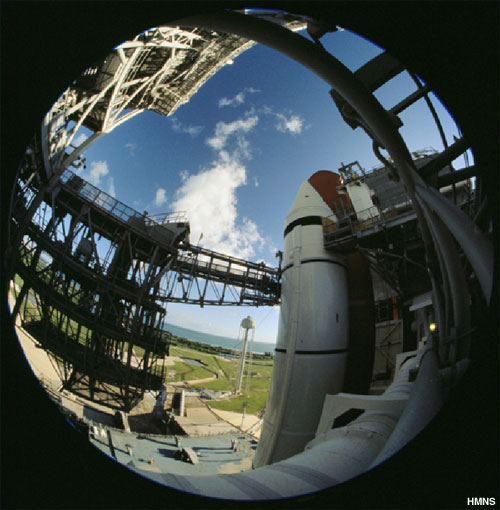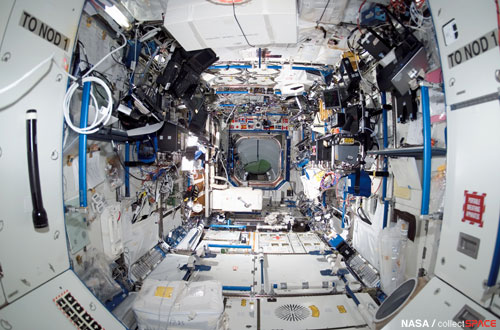|
|

|
|
Author
|
Topic: STS-120: First-ever flight of fish-eye cam
|
Robert Pearlman
Editor Posts: 42988
From: Houston, TX
Registered: Nov 1999
|
 posted 10-23-2007 12:22 AM
posted 10-23-2007 12:22 AM
   
Houston Museum of Natural Science release
STS-120 astronauts to photograph space flight for planetarium  quote:
Mission will be first-ever flight of fish-eye cameraFor the first time, astronauts will photograph and film their work and everyday life in space specifically for planetarium audiences. The Burke Baker Planetarium production team at the Houston Museum of Natural Science has trained the STS-120 Space Shuttle Mission crew to document their experiences using the fish-eye photography necessary for a projection on a full-dome screen.
Lift-off is scheduled for Tuesday, October 23 at 11:38 AM EDT.
"IMAX cameras have flown in space for many years," said Dr. Carolyn Sumners, the Museum's Vice President for Astronomy, and leader of the astronauts' training efforts. "This is the first flight for a camera capable of capturing a hemispheric view, which is required for planetarium projection. The Museum has previously trained scientists to take a large-format fish-eye camera to the North Pole and Ethiopia, but STS-120 is the Museum's first expedition into outer space."
With a Nikon F5 camera and a NIKKOR 8 mm lens, astronauts can capture an entire hemisphere of view in one shot. Images will be processed to produce a circular fish-eye image that is 4000 pixels across. Through a series of such images, astronauts will be able to take planetarium audiences down the corridor of the International Space Station or up to a window for a view from the flight deck.
Astronaut training has included extensive testing with the camera by the Photography and Television Training Team at the Johnson Space Center.
"This has been a very exciting opportunity to capture the entire spaceflight experience," said Gary Kilgo, STS-120 Photo/TV training lead. "We have had to develop new lighting and exposure techniques to illuminate an entire hemisphere. In these fish-eye images, planetarium audiences will see all aspects of the Space Shuttle and International Space Station."
Six crew members have been trained to use the camera individually and in teams: Commander Pamela Melroy; Pilot George Zamka; and Mission Specialists Scott Parazynski, Douglas Wheelock, Stephanie Wilson and Paolo Nespoli. Dr. Parazynski serves on the Board of Directors for the Houston Museum of Natural Science and has led this effort.
The training program included pre-training with the Johnson Space Center photography team and a day of training in the International Space Station and Space Shuttle training simulators with the STS-120 crew. The crew previewed their test shots in the Burke Baker Planetarium. Dr. Parazynski has also practiced shooting at the Kennedy Space Center in preparation for the mission.
NASA's STS-120 mission will transport a connecting module called the Harmony Node to the International Space Station. This Node will increase the orbiting laboratory's interior space and connect the U.S. segment of the station to the European and Japanese modules. Astronauts will use the hemispherical fish-eye camera on board to document these events, as well as everyday life in space. The still photographs and time-lapse movies they produce will immerse planetarium audiences in the experience of living and working in space.
Photographs taken by astronauts on the upcoming STS-120 mission will be displayed in planetarium shows as soon as the film returns from space and is processed. The full-dome fish-eye images will also be made available to planetariums around the world. Following the mission, the fish-eye images taken by the STS-120 crew will be available upon request from NASA Johnson Space Center's Media Resource Center.
|
cspg
Member Posts: 6210
From: Geneva, Switzerland
Registered: May 2006
|
 posted 10-23-2007 12:35 AM
posted 10-23-2007 12:35 AM
   
Does anyone know if photographic equipment manufacturers have a specific contract with NASA? Does NASA pay them or does, in this case, Nikon pays them?Chris. |
Robert Pearlman
Editor Posts: 42988
From: Houston, TX
Registered: Nov 1999
|
 posted 10-23-2007 01:02 AM
posted 10-23-2007 01:02 AM
   
quote:
Originally posted by cspg:
Does NASA pay them or does, in this case, Nikon pays them?
NASA has purchased cameras from Nikon in the past, most recently in August when the space agency ordered 76 D2XS digital SLR cameras, 39 NIKKOR Lenses, 64 Speedlight flashes, batteries and other accessories to support both flight and training requirements. While the press release does not state how STS-120's fish-eye camera equipment was provided, it may be similarly structured to how IMAX cameras have flown in the past, under the terms of a Space Act Agreement. On the missions that IMAX cameras flew, NASA retained ownership of all footage shot in space and provided IMAX a limited license to create feature films. |
cspg
Member Posts: 6210
From: Geneva, Switzerland
Registered: May 2006
|
 posted 10-23-2007 01:28 AM
posted 10-23-2007 01:28 AM
   
quote:
Originally posted by Robert Pearlman:
NASA has purchased cameras from Nikon in the past, most recently in August when the space agency ordered 76 D2XS digital SLR cameras...
Thanks for the info. Are those cameras specially designed for NASA use (at least the ones which fly)? I was also wondering if Nikon has used its space-used cameras for advertising, like watchmakers have done?Chris. |
Robert Pearlman
Editor Posts: 42988
From: Houston, TX
Registered: Nov 1999
|
 posted 10-23-2007 01:35 AM
posted 10-23-2007 01:35 AM
   
With regards to the D2XS, my understanding is that they are identical to those that you can buy from Nikon, with the exception of a special lubricant required by NASA for the camera's use on EVAs. The specific camera units are however, extensively tested by NASA before they are approved for flight use. Nikon has issued press releases about their cameras being used in space and the company has a representative at the Kennedy Space Center press site, but I have not seen Nikon advertise their cameras to consumers based on their spaceflight use. Keep in the mind that the models NASA uses are not consumer cameras but rather professional photographic equipment. |
John Youskauskas
Member Posts: 126
From:
Registered: Jan 2004
|
 posted 10-23-2007 03:05 PM
posted 10-23-2007 03:05 PM
  
Didn't the 41-B crew carry a camera similar to this back in '84? I beleive it was called the Cineflex 360 and was operated by Ron McNair. During a TV show, he demonstrated it and spoke about the film being projected onto planetarium domes.I never saw the film, though. |
Robert Pearlman
Editor Posts: 42988
From: Houston, TX
Registered: Nov 1999
|
 posted 10-25-2007 08:20 AM
posted 10-25-2007 08:20 AM
   
I've inquired with NASA public affairs regarding a clarification as to what makes this flight's fisheye a "first". In the meantime, NASA has posted three shots, including the one reproduced above, taken with the Nikon F5/8mm camera during crew training at Pad 39A: 1 | 2 | 3 |
Robert Pearlman
Editor Posts: 42988
From: Houston, TX
Registered: Nov 1999
|
 posted 11-05-2007 11:06 AM
posted 11-05-2007 11:06 AM
   
I do not know if this was taken with the fish-eye lens described in the press release, but this fish-eye photo, taken during the STS-120 mission, shows the International Space Station's Destiny laboratory:
Download the high resolution version (3.06mb) |
nasamad
Member Posts: 2121
From: Essex, UK
Registered: Jul 2001
|
 posted 11-05-2007 03:07 PM
posted 11-05-2007 03:07 PM
   
That could be taken with the fisheye Robert, I don't believe the D2Xs has a full frame image sensor, so therefore the image would be cropped but it would still be a wider view than normal. A 180 degree fisheye on a full frame sensor would show the same kind of distortion and dark corners as the earlier launchpad shots. Adam | |
Contact Us | The Source for Space History & Artifacts
Copyright 2020 collectSPACE.com All rights reserved.

Ultimate Bulletin Board 5.47a
|
|

|
 advertisement advertisement

|













